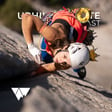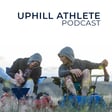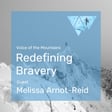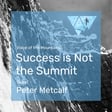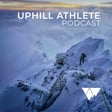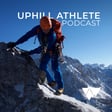Introduction to Podcast and Hosts
00:00:00
Speaker
Welcome to the uphill athlete podcast, where our mission is to elevate and inspire all mountain athletes through education and celebration. My name is Steve House, and I will be your host today along with Alyssa Clark. We're continuing our mountaineering series today with a familiar voice, our director of coaching, Chantel Robitai. Welcome, Chantel.
00:00:28
Speaker
Thanks, Steve. Hi, Alyssa. Hey, how's it going? Great.
What is Base Period Training in Mountaineering?
00:00:34
Speaker
In this episode, we focus on the base period of training and mountaineering training. Chantal, can you start us off with what base training is and why it's important? Absolutely. I think the first thing to start off with is probably people may know base training by different names.
00:00:55
Speaker
I think collegiate athletes are probably amongst all athletes, those who are most familiar with the term base training. And that's where they would typically be building plenty of miles or time on their feet at low, slow effort levels to prepare for their race season. And then they would start layering on other work like strength work, intervals, and other high intensity work.
Understanding Zone 2 Training
00:01:19
Speaker
Probably a more common name that it's been known by in
00:01:22
Speaker
Popular blogs, social media, et cetera, et cetera, over the last couple of years is zone two. We can't look around very far without seeing zone two being mentioned. So that's another way to describe this period. And really this base training period is where we are working to improve our work capacity and improve our resistance to fatigue. So really what we're looking to do
00:01:47
Speaker
is build our endurance through this type of lower effort, slower effort training, which doesn't always feel the sexiest, but it's probably the most important of all the training that we do because it really sets a good base for everything else that we need to do to prepare for mountaineering objectives.
00:02:12
Speaker
That's a great answer. And just to add on to that, I always call this section the unsexy work section, but it's really where you get the
00:02:26
Speaker
Like you get the meat and potatoes, if you eat meat, of your training program. And really where you need that consistency is in this period, even though it feels like, oh, it's so far out and it doesn't really matter. It really is such an important part of our training. It really sets us up with a great foundation. It's like the base of the pyramid. So Steve, with that, what are the three main principles to follow in base training?
Principles of Base Training
00:02:55
Speaker
Well, I think it's important to first to kind of piggyback on what you were saying, Alyssa, is to really emphasize that in the base period we're forging our metabolism and later on in the fun, as we call it, in the more specific periods, we'll be sharpening that.
00:03:17
Speaker
And the base period is so important precisely because this is when you're actually baking the cake. This is when you're actually forging the tool. The period before this with transition, I want to just go back to that for a second. That's the period where you're basically just making sure you're fit enough and healthy enough to train.
00:03:39
Speaker
and everybody needs to go back through that and address various problems. We've talked about that already. Get things going, get things set up, understand where you are strength-wise, endurance-wise. By the time you get to the base period, all that is figured out and it's time to just get to work like you said.
00:04:00
Speaker
I think that I always wanted to make a t-shirt about this, but I've never quite figured out how it's going to look. Maybe somebody in the audience will have an idea about continuity with gradualness and modulation and those three things. Continuity is what you said a minute ago that is like the consistency doing the training at the right
00:04:26
Speaker
about with the right time intervals. We can talk about that concept of training density. Gradualness is that you gradually increase the training load over time. Our bodies adapt to the stress we put upon
How to Increase Training Load and Allow Recovery?
00:04:41
Speaker
them. So if we are
00:04:43
Speaker
training for mountaineering and we're hiking with five hours a week. If we just hike five hours every week, we'll never be able to hike 15 hours a week because we will never have adapted to six, seven, eight, nine, 10, 11, 12, 13, and 14 hours a week. That's the gradualness and that's really important. Modulation essentially is a fancy word for taking recovery when you need it.
00:05:10
Speaker
In the base period, the traditional, I would say, most common, and Chantal can speak more to this probably than I can, but the most common layout is three weeks on and then one week off where you do roughly half of your volume. The rule of thumb for that recovery week is half.
00:05:32
Speaker
of the previous week's training volume. So that's the modulation. And the modulation happens over these like little cycles of say four weeks, sometimes that could be five weeks or six weeks. But it also happens over the longer period. Modulation can also apply to the whole picture of a year's training as well.
Aerobic Training Volume in Base Period
00:05:56
Speaker
But in this case, I think we'll restrict it to talking about the base periods since that's the subject for today.
00:06:02
Speaker
Excellent. And Chantal already touched on this by calling this period the zone two period, which has mixed reviews. Personally, I've always loved this. I love trading zone one, zone two. It's just kind of my bread and butter, but it's definitely not the easiest thing for athletes who have lived much more in the high intensity area of exercise. It can feel.
00:06:33
Speaker
Very difficult to slow down and feel like you're making progress. But how do we think about the distribution of this zone one, zone two aerobic training volume in our base period? Are we putting in any anaerobic work? Or how is that brought into this training? Or is it not brought into this training? So I'd love to hear either see Marc Chantel how we distribute this work.
00:07:03
Speaker
Oh, that's a big question. Um, and it kind of has that, that annoying coach answer. It depends, right? It depends who the person is, right? It depends. What has, what has someone's training looked like? You know, if someone has been doing, uh, plenty of aerobic work over the last few months, years, then they can, they can, their body is ready to handle perhaps a more,
00:07:31
Speaker
very distribution of intensity. However, if it's someone who is new to training in general or new to having a structured training plan, and I think particularly people who live in mountain towns are guilty of this, they go by what's going on, right? Oh, I've got an opportunity to do some skiing today. I've got the opportunity to go running. I've got the opportunity to go hiking.
00:07:55
Speaker
So their intensity distribution is all over the place. And when most people aren't really thinking about going out and doing things from a training perspective, everything they do is medium hard, right? Everything's medium hard. So they're not really working on their aerobic base with those types of activities. And so that's why a lot of them maybe find this to be challenging to slow down a little bit. And
00:08:22
Speaker
And they've done plenty of work and plenty of exercise, but they don't really have a strong aerobic base. So when we think about uphill athletes, one of the first things we do is try to figure out where is someone at? And that's why we usually start with our aerobic threshold test. And we see what someone's aerobic threshold is so that we can determine what is their zone two? What is their zone one? What does their aerobic work look like? And then if we feel they're capable, we will also
00:08:52
Speaker
want to do a test to see what their anaerobic threshold is. And the most important thing is really looking at the difference between those two. What does that gap look like? And if the gap between their anaerobic threshold and their aerobic threshold is greater than 10%, then we know that that person definitely needs to be spending more time in zone one and zone two because that's showing that their aerobic base is not very well developed.
00:09:19
Speaker
And you know, the reason why it can be unsexy quote unsexy work. I love zone one and zone two myself as well, Alyssa, but maybe that's us as ultra runners, right? Um, maybe the reason why it feels unsexy is because it takes quite a while to see results compared to when you're doing high intensity work. If you're doing, um, you know, intervals that are closer to your lactate threshold or even higher, you're going to see results from that training really quickly, right? In a matter of weeks.
00:09:49
Speaker
compared to our zone two work where it can take a matter of months to start seeing some results. So it kind of depends on where someone is starting, what their objective is, and how far away they are from their objective.
Transitioning to Anaerobic Training
00:10:07
Speaker
Yeah, I think that's great. And I would try to give some people some, let's say, rules of thumb here. And I'll just go off of our most popular training plan, the 24-week mountaineering training plan. And the first high-intensity workout in that is in week 13. So you've done
00:10:29
Speaker
a full eight-week transition period, four weeks of base period before you get any zone 3 higher intensity. And even then, that week has about 11 hours of training and you're in zone 3 for less.
00:10:45
Speaker
than one hour. I don't remember exactly, but I would have to look, but it's like 45 minutes or one hour in that first zone three interval workout. And then there's really only one of those per week because pretty soon you have to start changing your strength training, which we'll get to in a moment, and you're going to be working on muscular endurance training. And that is
00:11:13
Speaker
training that is very difficult or not difficult but takes time to recover from and for your body to absorb that straining stress and the resulting adaptation. So that's a really long way of saying
00:11:27
Speaker
Yeah, you don't need that much zone three for mountaineering training. And you don't need to do it pretty late, like halfway through a six month training plan is when you might do your first workout. And then you'll do them regularly for that second half of a six month training plan or work with a coach or something towards an objective. But it takes a while usually to get there. That makes a lot of sense. I guess, Steve, to maybe put you on the spot a little bit and
00:11:57
Speaker
Obviously, your climbing was at a much higher level than us mortals, but where did anaerobic training fit if it did fit into your base period when you were training for these big objectives? Yeah, it's a great question.
00:12:21
Speaker
I mostly did this kind of training like a zone three interval kind of training in my specific period, not even in my base period because especially when I was
00:12:38
Speaker
more focused in the latter part of my climbing career on really high altitude objectives, you just can't go anaerobic. I mean, if you're above 18,000 feet, you have half of at 18,000 feet and you have half of an atmosphere of pressure, so you have essentially 50% of the oxygen available that you have at sea level in that sense.
00:12:59
Speaker
And if you're climbing to a 26, 27,000 foot peak, it's 25% of the sea level atmospheric pressure. So it is all about aerobic at those high altitudes. If you're climbing in the Cascades or the Canadian Rockies or the Alps, it's different. Like 13,000 feet, yeah, it's high. You have a lower atmospheric pressure. You have less oxygen available. But there may be times where you need to
00:13:29
Speaker
you know, kind of quote unquote sprint across underneath some serax or you might need to move quickly and it might be useful. The other thing that I think is useful actually about zone three and our interval training in general is I like to think of it as strength training for the heart. It's really good for the heart muscle.
00:13:47
Speaker
And so there's something to be said for that. I don't know, maybe Chantel knows more about actually what the science says on that, but that was one area where I felt like that was a benefit because you are asking the heart to pump large volumes of water of blood very, very quickly and make hard contractions in these harder intervals. So you're just not doing it when you're in zone one or zone two.
00:14:14
Speaker
Yeah, I mean, I set you up a bit for that question, but you answered it proving exactly. I think the point that we're trying to make is that even someone at the the shark end of alpinism of mountaineering, etc, isn't doing anaerobic work until after the base period, which really emphasizes you're going to be okay, until the specialization period.
00:14:42
Speaker
So thank you, Steve. That's helpful. So switching directions, as I think that we preach zone two quite a lot. How do we look at strength training in the base period? How does it differ from other points in a program?
Role of Strength Training in Mountaineering
00:14:59
Speaker
And what are the goals that an athlete should be trying to reach within this, this strength base period? And Chantal, I'd love for you to start us off on this.
00:15:09
Speaker
Sure. So if we think about the base period, you know, from an aerobic perspective, what we're trying to do is set down a good foundation. We're kind of doing the same thing with strength here. And our focus on strength training at this point in an athlete's training program, it takes more of a supporting role.
00:15:28
Speaker
So think about strength training that is, has a focus on keeping you moving well, rather than focus on, you know, building big muscles or building maximum strength, like a bodybuilder might be, be training, right? We're looking at, if we think about what is important for a Mountaineer, you know, we're looking at, of course, aerobic capacity is important. Their strength is important, right? They've got to be able to carry heavy packs and
00:15:57
Speaker
and keep moving for many hours of the day. And they've got to be able to move efficiently. And if someone is not able to move efficiently, they're going to be wasting a lot of energy.
00:16:12
Speaker
going to be potentially putting themselves at risk for injury if they're not moving well. So that's why the focus here is kind of in a supporting role. And I know if I think about some of the athletes we have in our current mountaineering group programs, and they're saying like,
00:16:30
Speaker
OK, well, I'm doing this, following this Chamonix Mountain Fit program, and I really like it. And it's teaching me a lot about how I move and where my weaknesses are. But when can I get back to doing CrossFit? And I have to keep bringing them back to the point of it's showing you where your weaknesses are. And so we want to really look at what are, it's really easy for all of us, right, to, to train our strengths.
00:16:58
Speaker
But we really have to look at where those weaknesses are because those are the things that are going to cause us trouble down the line if we don't pay attention to that. So maybe your weakness could be potentially your aerobic capacity, right? Which we focus on in this phase. It could be the way you move. So making sure that you can identify whether you have any muscle weaknesses,
00:17:22
Speaker
if you can potentially identify any movement impingements within your body. So maybe you find that your left hip moves well, but your right hip doesn't. Maybe you find that you have limited ankle flexibility. Maybe you find that when you are carrying your backpack on your weekend hikes, you're constantly getting a sore neck or a sore lower back. Those are important things to notice during this phase. And so what we're looking at is
00:17:52
Speaker
trying to focus on not only just how much weight you can move, but actually how you're moving your body and making sure that you're moving well. Because if you have, let's say, a difference in your hips, let's say, from left to right, it's kind of like if you have
00:18:13
Speaker
on your car, a tire that is under inflated. Maybe it's fine to drive on that under inflated tire for a day to get you to the get you to the shop to, you know, put some more air in that tire or replace that tire. But if you continually drive on that under inflated tire, it's going to cause wear patterns on other tires and other parts of the car. And the same thing happens with the human body. So that's why we're not looking to
00:18:42
Speaker
go super hard in the gym. Again, we're looking at improving our aerobic capacity. If we're doing higher intensity strength work, we are taking away the focus from the Zone 2 work that we're doing. And so a lot of our programs, we're not bringing in any sort of strength work even that brings us into Zone 3 until much later in the program. So
00:19:06
Speaker
those first eight weeks are really focused on the basic, to use your words, Alyssa, meat and potatoes kind of stuff. Steve, do you have any follow-up on that? Yeah, no, I think that that's...
00:19:25
Speaker
Everything that Chantel said is true. And I want to just go back to fundamental
Neurological Adaptation in Max Strength Training
00:19:30
Speaker
principles. What are we trying to achieve with strength training when we're training towards a mountaineering objective? To me, it's two things. One, of course, we want to make sure that we don't get injured. And being strong is one of the best ways to make sure you're not going to become injured doing climbing mountain. And the other one is to unlock your kind of full potential
00:19:53
Speaker
for mountaineering and to be able to climb.
00:19:59
Speaker
This strength training has just sort of near universal benefits for us across all of these questions that we have. And in the base period of mountaineering strength training plan, you'll typically do two types of strength training. You'll do muscular endurance
00:20:25
Speaker
type of workout and we'll talk about that in a minute. But before that, we typically do a max strength protocol specifically for the lower body because mountaineering is obviously mostly legs and glutes.
00:20:41
Speaker
And so it's important to understand that with whatever transition period strength you did, and whether you're using Chamonix Mountain Fit or just a general strength routine of your choosing, that max strength is really important because
00:20:59
Speaker
what it's doing is taking the muscle fibers that you've conditioned through the transition period strength and it's teaching your body neurologically to fire them more together, if that makes sense. And so the whole thing with max strength and lifting heavy, it's actually not the way we do it and the way we approach it and the protocols that we give, it's absolutely not to
00:21:29
Speaker
to get bigger or whatever and you do get stronger. Yeah, you're not trying to get yoked and you do get stronger, but the reason you're getting stronger is because of the neurological adaptations that your body is making through the max strength period.
00:21:51
Speaker
the beauty of it. We're not adding any weight or maybe we are, but it's minimal. I've had athletes gain a pound or two. We're going to not talk about hypertrophy and
00:22:07
Speaker
when it's important to add muscle mass. We'll talk about that a different day, but just leaving that aside for a moment. Mostly, we're just going to be focused on lifting heavy for the most simple words I can put to it and doing that so that the muscles that wire together fire together is the little phrase. You're teaching your legs to
00:22:34
Speaker
the muscles in your legs, those fibers to fall fire together and do the work. And I think that that's really important for mountaineering. And this also goes for runners, if a runner is listening to this, because speed is a form of strength. The
00:22:56
Speaker
The power that you can exert is basically a function of the rate at which you can apply your strength. I think Chantel you said earlier, all we're doing with all of this is trying to become more resistant to fatigue.
00:23:13
Speaker
And at the same time, hopefully get faster. So that 10 hour summit day is an eight hour summit day. That's a massive difference in your safety and in your experience. And that means you're on the summit and back before the conditions get too soft, before the snow bridge over the crevasse softens and becomes a risk. All of these things, it's not just for fun. There's real important advantages to this kind of training.
00:23:44
Speaker
Yeah, that's something that I talk a lot about with phone consults with my own clients is in the mountains, it does become a safety difference if you are able to be fit and to continue to have the strength to move when you're fatigued. Absolutely.
00:24:04
Speaker
I guess to point out the strength component where the fear of getting big as you're doing the max strength, I mean, directly written in the book is a way to structure the reps and the rest sequence so that you don't
00:24:21
Speaker
end up trading like a bodybuilder. So I mean, you really explicitly write it out. And so kind of taking that fear off the table. Also, you're probably not crushing hundreds of grams of protein a day. I mean, you should have a high protein, but there's a really specific way that bodybuilders build this strength. And we're not doing that.
00:24:42
Speaker
This is not hypertrophy training. I just went through this with an athlete. I'm coaching. In eight weeks, she put on one pound, but that was from 104 to 105. Oh, wow. It's relative. Yeah, so it's relative, right? She's pretty small, and she's incredibly strong. She's deadlifting 3X her body weight.
00:25:09
Speaker
She's only putting on a pound of muscle. Is that worth it for what we're going to get out of that in terms of her boost in speed? That's probably a good trade off in that case. Yeah. I think with runners, you get that's where that is definitely a big fear where they're concerned about doing strength training and
00:25:32
Speaker
gaining weight and then that it's going to slow them down. And I think just if you think about Alyssa to your point about from Mountaineers, the safety aspect, if you're able to move faster and spend less time being exposed to the elements and or less time on your summit and you can have better awareness and all of those things, you know, safety is a big aspect. And I would say the same for any
00:26:00
Speaker
any of our listeners who are ultra runners, who are afraid of strength training, it's the same thing. It's actually not going to slow you down. It will benefit you in so many other ways, injury prevention being one, moving better being another, and spending less time out on the trail. If you can finish in a race, if you can finish Leadville, let's say, in 25 hours versus 30 hours, that's a
00:26:26
Speaker
big difference, not only in how you're going to feel by the end of it, you know, dragging your carcass to the finish line. You know, in the case of, if Leadville, it also could mean a different buckle, right? So it's a big deal to a lot of people. So it really does make a difference to be fitting the strength training in for, for all different types of athletes, just the way that strength training looks and how it's
00:26:53
Speaker
programmed or structured will look a little bit different. Excellent. And we will get more into strength training, actually in an episode coming up with a another amazing guest. So teaser alert. So
00:27:11
Speaker
Steve, especially I think I mean, we have a lot of athletes who might not have direct access to a gym to this type of equipment. I'm assuming that in your travels, you may have ended up in places where you didn't have, you know, squat rack or bar. So can you do this type of training without a gym? And what might that look like? And I guess specifically to you, how have you
00:27:41
Speaker
done this when you didn't have a gym accessible? Yeah. I tried to really discourage people from doing max strength workouts without a gym because a lot of times, for example, if you're doing back squats, your progression is another two and a half pounds or five pounds. You want to have that level of precision if possible because every week you want to be lifting it just a little bit heavier.
00:28:15
Speaker
tool that I've used in these situations is two things. One, a backpack and a travel scale. I take one of those little scales for weighing your luggage and the largest backpack and you can go out and you can fill it with whatever you have around that's heavy, whether that's rocks or water bottles or whatever. Then you can dial it in and then you can
00:28:36
Speaker
When that's not possible, I think that the best
00:28:41
Speaker
do some kind of back squat or something with that. I've also used the same kind of like a backpack but used it in like a goblet squat. So like holding it kind of under my chin in front of my chest and doing squats like that. I actually really like the goblet squat a lot. It's hard to do super heavy weights with that but I think that the way the weight is held is
00:29:10
Speaker
for a lot of people, it feels very safe because it's really easy to dump it in front of you. It's a really good tool for developing that correct posture for doing back squats and other forms of the lunges and all kinds of
00:29:27
Speaker
you know, these bipedal strength movements. And yeah, so same thing using a backpack or something and then just kind of filling it with some weight and then holding it up in front of me. It can be really awkward and weird, but you know, if you're traveling or you're off somewhere and that's what you need to do, then you know, you've already decided that you're going to do something comfortable and weird. So what's a one more thing?
00:29:56
Speaker
I think the point of that is it's not ideal, but it's possible. If you want to do this, as you said, a comfortable, weird thing, you can make it happen. You don't have to have the perfect setup to be doing good work. Absolutely.
00:30:18
Speaker
We've established this max strength. We've gained our max strength gains. How do we then take this and move into a different phase of what we call muscular endurance? I think people get really jazzed about muscular endurance because that feels like
00:30:38
Speaker
a piece of the puzzle that a lot of people don't utilize. So Chantel, could you help us understand how we take these max strength gains and we then translate them into our muscular endurance? Yeah, so if we think about muscular endurance, first of all, what what the heck is it? And it's, you know, the ability for someone to do a repetitive movement with a relatively high percentage of
00:31:07
Speaker
their max strength. So that's why the max strength phase is so important, because the muscular endurance phase kind of piggybacks onto that. So the stronger, you know, the better strength you are able to develop in the earlier phase, then during the muscular endurance phase, you're focused on being able to do more, more work at a higher percentage of your maximum amount of strength.
Muscular Endurance in Mountaineering
00:31:37
Speaker
is also, if you think about how we are training in our aerobic capacity, we are trying to do more work with less fatigue. And so this is the same thing that we're doing here, basically, is trying to improve our muscles endurance compared to trying to improve our aerobic endurance.
00:32:07
Speaker
Um, so if you think about, you know, what are you going to need to do when you are out on, on a climb or out on, you know, pursuing some objective or, or something like that, you're going to think about, you're going to be out moving around for a long time, probably carrying, you know, a good amount of weight. So that's why we want to practice some things that are going to be pretty similar.
00:32:32
Speaker
to the demands of those activities. So that's why you'll see in our plans, we will have weighted hikes where we recommend a certain percentage of body weight on your back. Like Steve said, sometimes you get creative where you're putting rocks in the pack or water bottles. And for those of you who have done it, it's sometimes pretty fun if you're doing it in an area where there are other people and they see you get to the top of the hill and
00:32:58
Speaker
empty your pack and start dumping out water bottles or pulling rocks out of your pack. But these are things that are, you know, a little bit, we're getting closer to your objectives. So we're getting, you know, into some specificity here to think about now you've built this amount of strength, how are we going to use it? And how are we going to make it practical? And that's where I think, you know, as you said, Alyssa, a lot of athletes get pretty jazzed about this, because it starts to, it starts to kind of come together and make sense
00:33:27
Speaker
And then they get to see how that that strength work has really now paid off. And I think that part of that is it also starts to look like what they perceive they're going to be doing on the mountain. So you see all these amazing pictures of Steve running in, in, you know, these amazing mountains carrying these backpacks, and it's looking really heavy and hard. And that's all you know, that's a really exciting
00:33:54
Speaker
thing to see and so I think that's what they visualize and they see muscular endurance and they get really jazzed about it because they're like okay I'm out of the gym where I was doing the back squats and all the things that most of us don't necessarily love being in the gym that are mountain athletes and so now we have you know that image of being up on the mountain working hard and and I think that's really exciting for people so I can see why why the appeal but what does
00:34:23
Speaker
Muscular endurance look like, specifically we're going to do the lower body and then the upper body. And how do you regulate intensity, steepness, the length of the climb in the vertical gain within this? Before I get into kind of the practical application, I just want to emphasize something that Chantal said that was really smart and clear. And that is that this concept that muscular endurance, you can even look at the word, right?
00:34:52
Speaker
It's two components. There's the strength of the muscle and the endurance of the muscle. And in muscular endurance training, we're sort of combining the two. And the stronger the muscle is, the less strength it needs to complete a certain task relative to its absolute strength. And the more endurance training the muscle is, the more contractions it can
00:35:13
Speaker
sustain or complete before it gets fatigued. And muscular endurance is sort of combining those two. And I think one of the things that also explains why this is so much fun is it is the most trainable quality that we have.
00:35:30
Speaker
And you do see incredible gains really quickly, especially if you've been diligent and done your whole transition and base period correctly. It's sort of like, I think of the forging example again, you've forged the tool
00:35:54
Speaker
And the better job you did on that forging process, the better the end product will be, right? And so we're at the end phase now. We're doing the polishing and the sharpening and so on. But this is exactly why it's so fun is because you're really getting the shape of what you're doing because you are doing exactly what
00:36:17
Speaker
looks like training. And the way you progress it is really pretty simple. You can progress it in multiple ways. Typically, with most athletes that haven't done a lot of this, I'll start them with 10% of body weight, which is usually too light. Don't take that as a
00:36:40
Speaker
uh, as a prescription to just go out and start with 20% of body weight, if you've never done this, because you need to get a little used to it. And one week is not, should not be a, uh, a big deal. Um, but start with something like that, like 10, 15% of your body weight and go out and do like for an hour or so. Um, and then start to ramp up a little bit every, every week. And you know, you don't want to, you can't,
00:37:07
Speaker
really do this workout more than once every seven days if you're recovering well. And as the workouts get harder, I might even space them out to 10 days. And you don't want to go with a heavier weight than you can go. It makes sense and it's logical and I coach athletes to a little heavier than what they're going to carry on the mountain. So if they're going to Denali and they might have a
00:37:37
Speaker
I don't know, 65 pound backpack. I might let them go up to 70 pounds, but there's no need to go to 100. You don't just need to kind of keep going and going and going because then you're training something that you're creating.
00:37:52
Speaker
Yeah, that's not necessary. So that's the one way to progress it. The other way you can progress it is with duration. So you start to make the intervals longer. When I have done these, I've mostly done them in places outside where I either had carrying rocks or carrying water, and I would basically be doing a lapse up some sort of
00:38:17
Speaker
usually I didn't do them on a trail because most trails aren't steep enough. Usually I just wore mountain boots that were old mountain boots and went up through the woods or through up the slope to get the steepest fall line I could. And I also want to another really excellent place to do these if you live in a ski town, especially in the summer, but even in the winter is on a ski slope. A steep ski run is a great place to do these workouts.
00:38:47
Speaker
But all that said, the duration can be ramped up as well. And so there's a lot of thought and debate that can go into exactly what those durations are, but they're probably starting at somewhere around an hour. And if I remember right, some of my longest workouts in this way were like four hours where I was doing like six laps or so. And those were exhausting, really hard workouts.
00:39:18
Speaker
What's the ideal length of vertical and weight you should be hitting by the end of this period? With the muscular endurance? Yes. It really depends on your goal.
00:39:34
Speaker
As Chantel said, it depends. The annoying coach answer, it really depends. So for example, if you're going to co-climb Mount Rainier, you know that that summit day is 4,000 vertical feet.
00:39:50
Speaker
What do you need to be able to do in training to climb summit day on Rainier? Well, do you need to be able to do 8,000 feet with 40% of body weight? No, that's way too much, honestly. The training does not need to be harder than the event. So for somebody climbing Rainier, I'm probably going to have them do something like a
00:40:15
Speaker
2,000 vertical feet with 20% of body weight. And that's going to be great. But what I may be doing is backing up two of those workouts on successive days right before they go. So they're doing like on a Saturday, they're doing maybe two hours total. So there's some warm up and cool down in there. So that's maybe 90 minutes of actual ME workout. And then maybe on the next day, they're doing three hours. So two and a half hours of ME.
00:40:43
Speaker
and that's going to be plenty. That's going to be plenty.
00:40:48
Speaker
Definitely. I mean, one of the principles from ultra running is you don't go run a hundred miles to train for a hundred miler. That's not going to work. Yeah. So not all of us are lucky enough to live with a ski mountain accessible. Uh, Chantal, can you give us some examples of what people can do if they don't live in the mountains? Because I know we have a lot of clients who are not quite as vertically gifted as others.
00:41:19
Speaker
Yeah, that's, that's a common question we get, isn't it? Um, and that's where you have to just get a little bit creative. So, you know, a couple of the ways would be doing box step ups. So, you know, there's, you know, maybe there's a box in your gym, or if you don't have access to a specific, you know, gym box, you don't need that necessarily. Uh, you could have a, you know, a bench at home or something like that that you could, or something that you could, you know, create that wouldn't be too hard. Um,
00:41:48
Speaker
The good old stair stepper mill is a good one or stair climber. You could crank up the incline on your treadmill. A lot of the treadmills nowadays have pretty good incline that you can get up to. So use that, take advantage of that if you have access to that either at home or at a gym. For those that maybe don't have access to a gym even, you know, if someone lives
00:42:15
Speaker
somewhere that's kind of inconvenient to get to a gym. They have to get creative. So I've seen people do climbing stairwells in taller buildings, stairwells in parking garages. I had once an athlete who lived in Florida and he would get his vertical by climbing the stairs on those
00:42:38
Speaker
you know, overpasses that go over road. That's what, that's where he was getting his vertical. So you might have to get a little bit creative and obviously it's not going to be, uh, maybe as fun as it might be in the mountains. But, uh, I like to think about is, you know, you get, you get a lot of bang for your buck here because you can think about it as being some really good mental training as well.
00:43:02
Speaker
Absolutely. I like to say that to clients too where it's like, think how much more fun it's going to be when you're out on Rainier and experiencing all of that and you know that you can go up and down on a box for two hours at a time. You're going to be great. If you can go up and down on a box for two hours at a time, there's a lot of stuff you can do in the real world. Yeah, that's way harder and hats off to those that can do it.
00:43:30
Speaker
Definitely. Yeah. And when it's blowing snow and not warm and the conditions are going crazy, you're like, I could be on a box right now. So, you know, things could be weird. That's right. I once coached an athlete who was an engineer on a cargo ship.
00:43:46
Speaker
So he did his ME workouts in the stairs inside the ship, which was huge, right? So I can't remember how many sort of floors it was, but I want to say it was like eight floors or something, but the GPS data was crazy because of course the ship is moving. The ship is just moving forward. It's also moving up and down and he's moving up and down. So it was a complete disaster for trying to figure out the data. I just had to sort of throw the data away.
00:44:16
Speaker
Yeah, that would be tough. But I bet he did really well on the actual climb because he was... Yeah.
00:44:22
Speaker
Yeah. He was motivated. He went and climbed. I mean, that was what he liked about that job is that he was the ship engineer for like one crossing. And then so that would take whatever, a chunk of time. And then he had a big chunk of time off. So that's a workout. So he had time to go climbing. And he actually, because he was always going to Asia, he was going climbing in the Himalaya a lot and worked out really well for him. Oh, nice. That's super cool.
00:44:47
Speaker
So we've talked a lot about the lower body, but mountaineering, you do have to carry a heavy pack, you know, you do have to have upper body strength and endurance. So how do we go about training muscular endurance for the upper body? Steve, if you want to take this on.
00:45:05
Speaker
Yeah, absolutely. Well, there is a free, and it's one of my personal favorite workouts, there's a free gym-based muscular endurance workout on the website we can link to in the show notes. And you can do muscular endurance training that way. And it's more of like a circuit style ME, and it includes things like box step ups, but it also includes upper body.
00:45:29
Speaker
Work and there's a lot of different ways to do that we also have developed things like for people going to deny and Everest we've developed like.
00:45:44
Speaker
essentially a Jumar workout on a rope because people were coming back to us and saying like, yeah, my legs were great, but I had to move the Jumar up on the rope. My arm was exhausted. And I was like, oh, okay. Well, we got to come up with a way to train that. And so all of these things can be done with some sort of creativity, I guess, for lack of a better word.
00:46:07
Speaker
But some of the classic ways, of course, are just to go do long climbs outside, to go to the climbing gym, to use a rotating climbing wall like a tread wall. I developed this exercise where I would
00:46:27
Speaker
kind of set a treadmill on a really slow speed and then walk on my hands like basically to make a plank position on the floor with my hands on the treadmill and just set it for – it's really hard. So you have to set the treadmill for – That sounds extremely hard. Really slow but it's a great ME workout and you can – every hotel gym has a treadmill, right?
00:46:49
Speaker
Yeah. So that's a good little tool. Don't expect that you can do it for many minutes at a time though, because you're using... It's a very interesting exercise actually.
00:47:01
Speaker
But yeah, I think that there's a lot of things. I think the first time I actually saw this going on was years ago. I wanna say I don't even know what year it was. I wasn't even 20 probably. So this was over 30 years ago. And I remember being at Smith Rock Climbing and seeing this, the kind of top American climber at the time and the first American to establish a 514.
00:47:30
Speaker
was this guy named Scott Franklin, and Scott was on this 513A with a weight vest. He was on a churning in the wake, it's called. And I remember just being blown away. And he was just throwing laps on this thing, a 513 and wearing a weight vest. And I was like,
00:47:54
Speaker
Okay, I didn't know what that was, but that's what that was. It was muscular endurance training. He probably didn't know what it was, but he kind of from wherever put some ideas together and did that and later became the first American to climb a 514.
00:48:09
Speaker
and just around the corner from where he was training. So I mean, I think that we should never discount creativity and kind of understanding these basic concepts and then applying it in new and creative ways to help us accomplish what we want to do.
00:48:27
Speaker
I now want to try, I'll be in a hotel this weekend and I really want to try treadmill hand walking. I know. I was thinking the same thing. After this meeting, I'm going to turn on my treadmill, make it really slow, ask for a spotter and give it a try. I mean, nothing really happens. You just kind of fall on your face. Yeah. I think I might wear gloves too because treadmills are not clean. It's actually very true. They're not clean at all. Yeah.
00:48:54
Speaker
Yeah, it's a good point. Yeah, and some of them are really dirty. Especially the gym ones. The tentacles at home is probably nice and clean. Yeah, mine's probably not too bad, but yeah, you know, I guess if it's in a gym or in a hotel, you know, getting lots of use, you don't, yeah. I wouldn't want to see a blue light on one of those with all the
00:49:15
Speaker
different people sweating all over them. Yeah, I don't think I would either. So the last point that I want to touch on, and we won't go too deeply into it, because we're gonna kind of separate mountaineering from alpinism, because we'll talk about alpinism later on. But if you were looking at a mountaineering objective versus an alpine objective, how would you differentiate the base period for
00:49:42
Speaker
the two of them? What would be some of the differences that you would see? I think the main thing to think about is the differences between the two and with, you know, for mountaineering, the main concern is overcoming
00:49:55
Speaker
the conditions at the high altitudes, right?
Training Differences: Mountaineering vs. Alpinism
00:49:58
Speaker
That's the one big thing. Obviously getting up the mountain is a big one, but you're really thinking about those conditions. And when we're thinking about alpinism, we're thinking about overcoming, we've got obvious, you know, most of the time we're thinking about those same conditions as with mountaineering, but we're also have the additional
00:50:19
Speaker
technical challenges that are involved with those types of objectives. So then we're thinking about, you know, rock climbing and ice climbing, potentially both, you know, mixed climbing as well in some of those objectives as well. So when we think about a training plan for those two, there will be a lot of similarities, but it will be those specific aspects to the training that will be different to make sure that that
00:50:47
Speaker
the athlete is prepared for the specific challenges of that objective. And you could have the same mountain that might be considered a mountaineering objective in one season, but an alpinism objective in another season based on the technicalities and changes at different times of the year. Definitely in different route selection. I mean, right here, there's a tremendous amount of variation of technicality that you can get depending on what route you choose.
00:51:18
Speaker
So yeah, so you want to take those into consideration. And then also, again, looking at the individual themselves, right? How much experience do they have with, with doing that type of objective in the past? What's their comfort level? What's their experience level? What are their, and again, coming back to what we talked about in the beginning, you know, when we're looking at assessing an athlete, what are their strengths and challenges and making sure that we
00:51:45
Speaker
Of course, we want to continue building those strengths, but we really want to hone in on what those challenges are because, you know, and those high mountain objectives, you know, the, the consequences are high. And we want to make sure that someone is as prepared as possible in all realms from, you know, from the
00:52:06
Speaker
the technical aspect to their aerobic capacity aspect to their strength and even muscular endurance aspect. All those things matter, but they're going to be a little bit different. Yeah, and I would just add that, you know, to, there's, to me, four
00:52:28
Speaker
There's more, but there's four main things that we can talk about that is going to lead to being a strong and successful mountaineer. One is aerobic efficiency. One is your speed and speed is related to strength as we discussed. Another is your muscular endurance capacity. And then the other one is your technique. And even just for the easiest route on Mont Blanc or Mount Rainier, there is a massive difference between someone who's super efficient in their
00:52:57
Speaker
technique and somebody who is not. And so that factor alone, if you never trained that, you can be the strongest. And I've seen that in my guiding career, I saw this so many times, you'd see people who are super strong and you would see people who are super weak. And depending on where their technique was on that continuum, they would either do well or not. And that can override everything. So let's not forget that.
00:53:23
Speaker
We can't train that in the gym, but we can gain experience. And so that's important to factor in. I think that's such a great point. I mean, we were out ski touring this past weekend and just watching the difference of people going uphill, those with a kick turn technique that wasn't dialed in were
00:53:44
Speaker
working so much harder. So they might be really fit, but the expenditure of energy was so much higher because of their inefficiency of technique. And so I think that's a really important point to make and just goes to the point that you really have to work on the skills set as well. Yeah, you can hear it. Oh, yeah. Yeah.
00:54:05
Speaker
Yeah. You can hear it. They're coming up the skin track. They're slapping and lifting their feet way up. And I did that too. I'm not putting anyone down. We all went through that. But I didn't learn. I just did thousands of hours of it until my body learned the most efficient movement pattern.
00:54:22
Speaker
And we have to train those movement patterns too. Like that's not, you know, and that's why a coaching, you know, tips like technique coaching is so valuable because you can correct movement patterns and teach your body the more efficient and the better one. And I mean, running is a prime example. We could talk all day about that, I'm sure, with you too. But that's outside of tonight's discussion.
00:54:45
Speaker
Well, I think that just about wraps us up. Is there anything else you'd like to touch on Steve or Chantal before we close out? I think the biggest thing is to think about, you know, we talk about like the quote unquote unsexiness of base training. If you feel that way about it, try to find a way to turn it around because it is so integral to everything that you're going to do, regardless of what type of athlete you are. Um, so,
00:55:14
Speaker
try to reframe that, try to find a way to put it in a different perspective or a different spin on it so that you can rather than going out and dreading it or just constantly turning every zone two workout into a zone three workout because you're not paying attention or you don't like it or you have a negative thought about it. Try to reframe it in your head and find a way to enjoy it and remember that it really sets the stage for everything else you're going to do to reach your goals.
00:55:46
Speaker
Yeah, and I would just add to that, stay connected to the magic. If you're a mountaineer, it's because you love being in the mountains and don't let
00:55:56
Speaker
The training should never supersede the motivation and you should always continue to dip into the mountains and to what inspires you about the mountains to keep that part of you alive because that's really what we're doing this for. We're not doing this to beat anyone or run a faster time than whatever. It's about being in the mountains, enjoying the mountains,
00:56:21
Speaker
being safe and of course having a long and and Varied career as a mountaineer and that's what it's it's for. So always just stay connected to the source. I Love it. Good reminder. Yeah, I I spend a lot of time visualizing in this period I think that's always a great place to be where you're envisioning how this work is going to pay off and and what you're going to feel and how great you're gonna feel and
00:56:49
Speaker
because you're, you've done the work. Yeah, that's actually a great tip. Yeah. No, it's, uh, I do that a lot with racing. I mean, that that's more of an outcome, but it's like, okay, this is the work that is going to allow me to do what I want to do out there. Yeah. So.
00:57:08
Speaker
Well, thank you both for being on this. Thank you all for listening to the uphill athlete podcast. We ask that you rate, review, and subscribe on your favorite podcast platform. You can also visit us at uphillathlete.com. And we really appreciate you taking the time to tune in. And remember, it's not just one, but a community. Together, we are uphill athlete. Thanks for listening.








